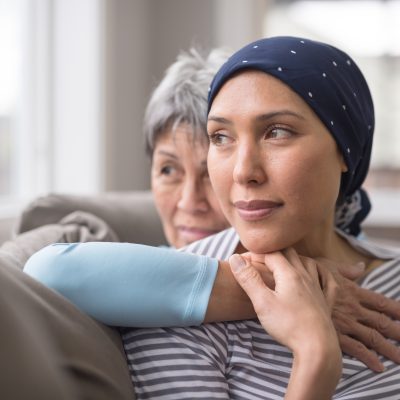Creating an Individualized Breast Cancer Treatment Plan

Your doctor will consult with you and determine a suggested treatment plan, possibly different from these general treatment options.
The most common treatment options are:
Surgery
Currently, there are two surgical options to treat breast cancer:
- Mastectomy — During a mastectomy, the entire breast and underarm lymph nodes are removed.
- Lumpectomy — During a lumpectomy (also called a breast conserving surgery or partial mastectomy), the cancerous mass, the surrounding tissue and usually the underarm lymph nodes are removed. This procedure keeps as much of the breast tissue as possible.
Radiation Therapy
Radiation therapy is often used after a lumpectomy to help reduce the risk that cancer will return to the nearby lymph nodes or breast area. Radiation therapy uses high-energy rays or particles to destroy any cancer cells. Radiation also may be suggested after a mastectomy for patients with a large cancerous mass, or when the cancer has spread to the lymph nodes.
Chemotherapy
Chemotherapy (chemo) is a treatment in which drugs are used to destroy cancer cells. Chemotherapy may be recommended if the cancer has a strong chance of spreading or returning. Chemotherapy is likely to be recommended if the cancer has already started to spread throughout the body.
On some occasions, chemotherapy will take place prior to surgery in patients with larger breast tumors. The goal is to shrink a tumor to a size that makes it easier to remove with surgery.
Hormone Therapy
Studies have shown the estrogen can promote the growth of some forms of breast cancer. Hormone therapy is designed to block or counter the effects of estrogen. Hormone therapy is commonly used to fight breast cancer cases that are sensitive to hormones, such as estrogen positive or progesterone positive cancers.
If the cancer has already spread, hormone therapy can be used to reduce the size and control it. Hormone therapy also may be used to reduce the risk of the cancer returning.
Targeted Therapy
As researchers have discovered more about the gene alterations in cells that lead to cancer, they have been able to create drugs that specifically fight these changes. Certain targeted therapy drugs have been designed to assist hormone therapy drugs and fight the cancer cells.
In some forms of breast cancer, patients will have cells that produce excessive amounts of protein. The additional protein will cause the cancer to grow and spread more rapidly. Researchers have created a drug that is designed to help these patients and restrict the amount of protein produced.
Bone-Directed Therapy
Bone-directed therapy is designed to lower the risk of cancer spreading to bones. When cancer does spread to bones, it can cause pain and potentially lead to fractures.